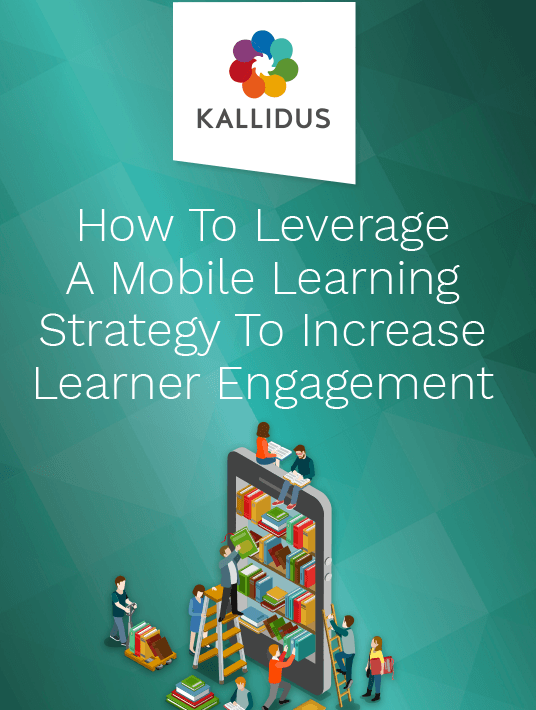Why It's Important To Create A Solid Mobile Learning Strategy
So you’ve taken the plunge and invested in a mobile-friendly LMS. This is a great first step towards bringing your eLearning strategy into the more flexible and focused realm of modern workplace learning. Alongside the wide range of benefits that mobile learning can bring to your organisation, it is important to create a solid strategy for your new approach to training. A learning strategy specific to mobile will help your organisation to remain focused, decide learning outcomes, and ultimately deliver more successfully on the KPIs that led you down this road in the first place. Here are just a few of the benefits of creating a mobile learning strategy before you embark on a more technologically focussed journey for your learners.

Keep Learners Engaged In Their Training
One of the most important parts of any learning strategy is focusing on learner engagement. A solid mobile learning strategy will help you to keep your employees engaged in their workplace training. Whether you want to begin your new mobile learning endeavour with a curiosity campaign or gamification, getting your learners involved before and during the launch of your new training is a great way to increase learner engagement. Ultimately, this can only be managed with a strong mobile learning strategy, with planning and time dedicated beforehand. After the launch, your strategy will help to keep your learners engaged and should be adapted according to the results (in terms of completion, additional courses, etc) recorded within your LMS.
Improve Planning And Communication With Focused Reporting
This brings us to the next step: reporting on your learning activity. Having a mobile learning strategy enables you to focus your reporting much more clearly. You can tailor your reports within your LMS to suit the KPIs your strategy is focussing on, for example improving completion rates and engagement levels of your remote workers. Alongside allowing you to continually improve the results of your learning overall, having a solid learning strategy with clear KPIs eases the process of reporting internally to your top management and HR teams. With clear statistics and reports demonstrating the effectiveness of your strategy, this enables greater transparency within your organisation.
Make Mobile Learning Work For Remote And Field-Based Workers
One of the main benefits of mobile learning is the increase in flexibility it offers remote and field-based workers. With remote and field-based working set to rise in 2019, it makes sense to invest in these workers’ training as much as those based at HQ. A mobile learning strategy will allow you to tailor your implementation and planning towards creating a greater benefit to your employees on the road or based elsewhere. One of the key parts of engaging your workers, especially those who work remotely, is to ensure they are as clued up and keyed into everything those at HQ are. Personalising the learning of your remote workers can do a vast amount to improve their learning engagement, and this can and should be one of the main focuses of your mobile learning strategy. Your remote and field-based workers are key to the success of your organisation’s ongoing Learning and Development and, especially when it comes to mobile learning, can benefit hugely from a focussed strategy.
Tailoring Your Content For Mobile
Investing the time in a solid mobile learning strategy enables you to focus more clearly on the content you are going to deliver to your employees. Mobile learning requires different content to desktop or classroom-based learning, so it’s worth investing in a partnership that promotes microlearning as a key part of any strategy. Microlearning breaks up more traditional eLearning content into small chunks of 2 – 10 minutes, allowing not only for mobile devices of any kind but also for the busy schedules and shorter attention spans of modern learners. It’s not unusual for employees to need to squeeze in training between meetings, commutes, and various other work commitments. In a world where our employees are busier than ever, investing in microlearning as part of your mobile learning strategy plays into the strengths of the modern workforce as well as fitting into their schedule.
Prioritise On-Demand Learning
One of the biggest benefits of mobile learning is allowing for on-demand or point-of-need learning. This can come in many forms, including refresher training on specific warehouse equipment to a quick overview of an internal IT system. Point-of-need learning is shown to increase learner engagement and information retention as it allows your employees to access the information they need when they need it, as opposed to on mandated dates and times according to their compliance schedule. On-demand learning doesn’t just benefit the completion and retention of compliance training. It can allow your employees to continuously develop themselves in areas they may not otherwise train in. Mobile learning is a great way to prioritise this as it positions your LMS as a mobile hub for continuous learning as opposed to the more typical routes of Google or YouTube. Prioritising on-demand and point-of-need learning can be done most effectively through a strong mobile learning strategy and if you’re looking to improve completion rates and engagement, you should take a front seat. There are many benefits to investing in a mobile learning strategy, and here are our top 5. Continuous learning and self-driven development are both of great importance for your organisation’s employees. A mobile learning strategy is the first step to making these happen and potentially changing the workplace culture towards learning entirely.
Download the eBook How To Leverage A Mobile Learning Strategy To Increase Learner Engagement to learn how collaboration, microlearning, strategy development and a transformation to mobile learning can enable you to really boost engagement.

